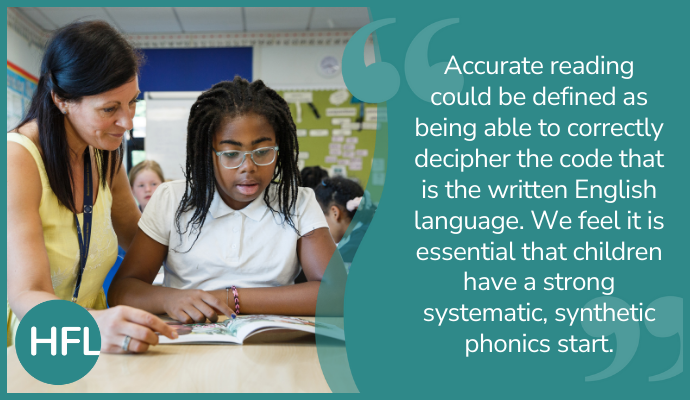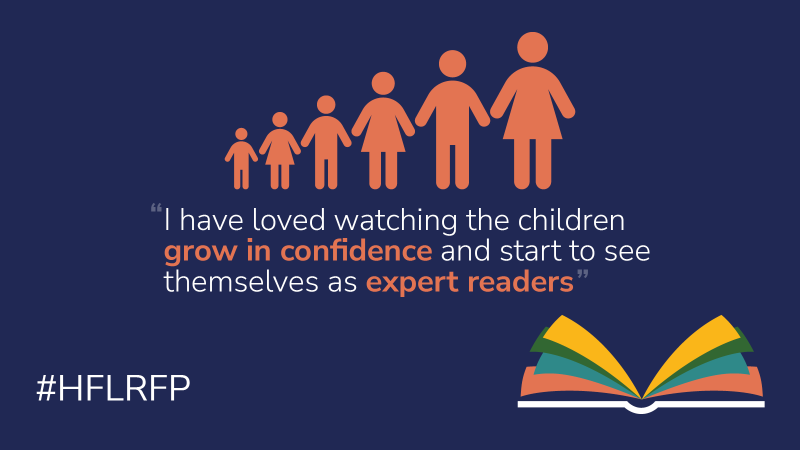
What is reading fluency?
At HFL Education, we have been rather obsessed with shouting loudly about the benefits of pedagogical approaches for reading fluency for quite some time. Take a look at this blog from 2016. We don’t like to think of a ‘fluent reader’ as a child who has reached ‘lime band’ and is now permitted to access the rich and varied world that literature has to offer. We recognise that fluent reading of literature can happen at all ages and stages. As Kirsten points out, a 3 year old pointing to the lure of the golden arches is fluently reading for their age! The letter m is being beautifully read with appropriate comprehension.
So how ought we define reading fluency? In a document produced by the EEF and in collaboration with HFL Education, reading fluency is defined as being a combination of automaticity, accuracy and prosody. When a child can apply these three components of reading to a text which is appropriately pitched for them, then we might say that they are reading fluently. The hope is that, when a child is able to read fluently, there will be cognitive space for comprehension, as brain power is not being consumed in the act of decoding.
What’s the difference between accuracy and automaticity?
Accurate reading could be defined as being able to correctly decipher the code that is the written English language. We feel it is essential that children have a strong systematic, synthetic phonics start. They need to know the GPCs present in the texts that they’re reading in order to be able to decode the words. When a child reads with good accuracy, we note that they are able to read an appropriately pitched text with few or no mispronunciations, word substitutions or word omissions.
On our HFL Reading Fluency project, we often have teachers talk to us about children like Jai. Jai was in year 5; he had passed his phonics screening check. When reading a text which felt nice and easy for him, for instance a much-loved key stage one picture book or indeed a series of flash cards, Jai could decode with accuracy. However, when asked to read a more complex text, pitched correctly for year 5, all of that phonic knowledge seemed to disappear. Jai’s ability to read with accuracy deteriorated. He started stumbling over words and forgetting to use those strategies of sounding out and blending which he does possess. Jai had a lack of automaticity. We often find, when supporting schools, that children like Jai are given additional support in the form of catch-up phonics. However, we discovered Jai’s accuracy was sound when reading words in isolation; he needed to build his automaticity. He needed to be able to read those words instantaneously, on sight, without overtly sounding out and blending. This would put an end to the stumbling and crunching through words that we were seeing, and the disregard for punctuation. There was simply no cognitive space left to think about how to read with flow and expression as all the space was being consumed in the act of word reading.
How can we support our children like Jai with improving their automaticity? One of the key approaches which we employ on the HFL Reading Fluency project is repeated re-reading. In the act of reading the same text over and over, automaticity, and therefore accuracy improve. We employ strategies to make the repeated re-reading of a chosen text enjoyable and motivational. For instance, asking children to practice and perform a poem really incentivises reading over and over for an authentic purpose. Once they have done this a few times, all the words on that page will be read with automaticity and of course, many of those words appear in other texts.
Prosody
In addition to accuracy and automaticity, prosody is the third component forming the definition of fluency. Prosody is the reader’s use of expression, fluidity, phrasing and musicality. This happens both orally and in the reader’s head. Reading with prosody is clearly an outcome that we could expect our comprehensive readers to demonstrate. However, we have discovered on the HFL Reading Fluency Project that prosody is also a precursor to comprehension. When reading out loud or when reading in our heads, we use the musicality and phrasing in our internal voice to support us with comprehending the text at the point of reading. Applying prosody at the point of reading actually supports us to understand the text. There are various strategies which we employ on the HFL Reading Fluency Project to support children with developing a sense of prosody when reading. These include echo reading, choral reading, and assisted reading. When these are artfully combined with strategies for repeated re-reading, we see really powerful impact on reading achievement in a really short space of time.
Impact
Let’s consider Jai again. A child who perceived himself to be a non-reader. A child who actively avoided participating in reading lessons and one who rarely read for pleasure. As a result of 8 weeks of intervention, where comprehension has been allowed to flourish as fluency developed, Jai was able to leave primary school having reached the expected standard in reading, with a sense of pride and a determination, fully ready for the challenges of key stage three. Jai’s self-esteem improved and his teacher and parents were overjoyed with his newfound enthusiasm for books. We have now worked with over 2000 children, supporting them to achieve all that Jai did. Employing strategies designed to address reading fluency, like those outlined in this blog, will have a huge impact on those children who need it the most.
For recent analysis of our Fluency Project’s qualitative and quantitative data, please see our Reading Fluency project blog.
To join us on the next round of the project (which is delivered remotely): KS1 (years 2-3) and KS2/3 (years 4-7).




